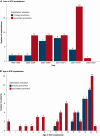Implantable cardioverter defibrillator therapy in paediatric patients for primary vs. secondary prevention
- PMID: 39345160
- PMCID: PMC11440178
- DOI: 10.1093/europace/euae245
Implantable cardioverter defibrillator therapy in paediatric patients for primary vs. secondary prevention
Abstract
Aims: The decisions about placing an ICD in a child are more difficult than in an adult due to longer expected lifespan and the complication risk. Young patients gain the most years from ICDs, despite higher risk of device-related complications. The secondary prevention ICD indication is clear, and device is implanted regardless of potential complications. For primary prevention, risk of sudden cardiac death and complications need to be evaluated. We aimed to compare outcomes for primary and secondary prevention ICDs.
Methods and results: Retrospective nationwide cohort study including paediatric patients identified from the Danish ICD registry with ICD implanted at an age ≤ 15 from 1982-21. Demographics, complications (composite of device-related infections or lead-failure requiring re-operation, mortality because of arrhythmia, or unknown cause), and mortality were retrieved from medical charts. Endpoint was appropriate therapy (shock or anti-tachycardia pacing for ventricular tachycardia or fibrillation). Of 72 receiving an ICD, the majority had channelopathies (n = 34) or structural heart diseases (n = 28). ICDs were implanted in 23 patients for primary prevention and 49 for secondary prevention, at median ages of 13.8 and 11.6 years (P-value 0.01), respectively. Median follow-up was 9.0 (interquartile ranges: 4.7-13.5) years. The 10-year cumulative incidence of first appropriate therapy was 70%, with complication and inappropriate therapy rates at 41% and 15%, respectively. No difference was observed between prevention groups for all outcomes. Six patients died during follow-up.
Conclusion: In children, two-thirds are secondary prevention ICDs. Children have higher appropriate therapy and complication rates than adults, while the inappropriate therapy rate was low.
Keywords: Appropriate therapy; Congenital heart disease; Implantable cardioverter defibrillator; Paediatric cardiology; Sudden cardiac death.
© The Author(s) 2024. Published by Oxford University Press on behalf of the European Society of Cardiology.
Conflict of interest statement
Conflict of interest: C.J. receives lecturing fees from Abbott and Biosense Webster. P.S.B. receives educational grant from Abbott, fellowship/scholarship grant from Boston Scientific, and an external research support (ERP-2021-12822) from Medtronic. LS. is chief medical officer and divisional vice president at Medical Affairs, Abbott Structural Heart. J.C.N. received institutional research grants from the Novo Nordisk Foundation and the Danish Heart Foundation outside this work. The remaining authors have no conflicts of interest to declare.
Figures




References
-
- Baskar S, Bao H, Minges KE, Spar DS, Czosek RJ. Characteristics and outcomes of pediatric patients who undergo placement of implantable cardioverter defibrillators: insights from the national cardiovascular data registry. Circ Arrhythm Electrophysiol 2018;11:e006542. - PubMed
-
- Czosek RJ, Meganathan K, Anderson JB, Knilans TK, Marino BS, Heaton PC. Cardiac rhythm devices in the pediatric population: utilization and complications. Heart Rhythm 2012;9:199–208. - PubMed
-
- Walsh EP. Practical aspects of implantable defibrillator therapy in patients with congenital heart disease. Pacing Clin Electrophysiol 2008;31 Suppl 1:S38–40. - PubMed
-
- Writing Committee Members; Silka MJ, Shah MJ, Silva JNA, Balaji S, Beach CMet al. . 2021 PACES expert consensus statement on the indications and management of cardiovascular implantable electronic devices in pediatric patients: executive summary. Heart Rhythm 2021;18:1925–50. - PubMed
-
- Jordan CP, Freedenberg V, Wang Y, Curtis JP, Gleva MJ, Berul CI. Implant and clinical characteristics for pediatric and congenital heart patients in the national cardiovascular data registry implantable cardioverter defibrillator registry. Circ Arrhythm Electrophysiol 2014;7:1092–100. - PubMed
Publication types
MeSH terms
LinkOut - more resources
Full Text Sources
Medical

